Quantitative Life Goals: How to Plan and Finish What You Start

Whatever I’ve achieved so far, I can attribute entirely to setting good goals.
With Programming for Marketers, our goal was to get 2,000 signups in our first week. We got 2,900.
With Become a Technical Marketer, the goal was $25,000 in sales in two weeks. We made $48,000.
For SumoMe, I’ve had goals around getting more users, getting paid upgrades, and producing a certain amount of content… But I can’t tell you those since they’re secret 😉
This has even worked for putting on muscle, losing weight, reading more, and other “non-professional” goals.
If you’re reading this site, then you likely have goals of your own, but may not have an iron-clad framework for hitting them.
So to help you out, here’s the system I’ve developed (mostly by stealing bits and pieces from other people, in some ways this is quant-based marketing applied to life) that will get you there.
Step One: Set a Time-Frame
Depending on how far-thinking you like to be, pick a time-frame of a year, 6 months, or 3 months.
I’m notoriously bad about procrastinating, and my side-interests tend to bounce around a lot, so I go with 3 months.
I also find (and research has supported) that we overestimate what we can do in a short time-frame (i.e. a day or week, but also as long as a year).
But ,we underestimate what we can do in a longer time frame (multiple years or a decade), so the trick is to set goals somewhere in the middle.
For me, that’s 3 months.
Sidebar : This doesn’t mean you can’t think beyond 3 months, but I find it’s helpful to have a shorter timeframe to assess your goals within.
Setting a goal for a year, if it’s not big enough, might result in procrastinating till October.
Step Two: Pick 1-3 Goals
For years, I’ve been using a rough version of the productivity system outlined in Getting Results the Agile Way, which suggests setting goals in groups of three or fewer.
If you try to set a dozen goals, you’ll get distracted and likely not hit any of them.
Setting one goal is ideal, but you might have a couple of things you want to work on (as I do) or you might thrive from combining a couple goals that can support each other (also, as I do).
So sit down and ask yourself:
“If I achieved nothing else in three months, what would I be most (satisfied with, proud of, relieved by, excited about)?”
This could be:
- Working out a certain amount
- Hosting a certain number of dinners
- Reaching a certain amount of site traffic
- Earning a certain amount of money
- Going on a certain number of dates
- Lasting longer in bed
Here are mine for the next three months (on top of my main goals at work):
- Grow this site’s subscribers to 3,500 (currently ~1,700)
- Reach $1,500/mo in recurring passive income
- Learn some Swift + launch a very basic app for men’s kegel exercises
Sidebar: How big of goals?
There are two philosophies to goal setting:
You should set goals that are easily obtainable to keep you motivated.You should shoot really high so that even if you fail you still outperformed your assumptions.
I follow the second belief: I’d rather shoot for really high goals and only hit 80% of them than shoot for something easy and lose some of my potential output.
Ultimately it’s up to you… but come on, no one got anywhere interesting by setting small goals.
Now, you just need to make sure your goals aren’t stupid.
Step Three: Make Sure Your Goals Aren’t Stupid
If you’re not already in the habit of setting good SMART goals, then take a second and make sure whatever goal you set isn’t a bad one.
The easiest way to check is to see if you will be able to easily know if you’ve succeeded at your goal. There’s no way to evaluate yourself if your goal is “start writing,” but it will be very clear if you succeeded at “publish something ever week.”
Similarly “start working out” is useless, but “go to the gym 3 days a week” has a clear success / failure metric.
Step Four: Build Your Quantitative Life Goals Spreadsheet
Whatever your goal(s) are, you can’t just set them and then check in after 3 months and see how they went. This is true whether you have more quantitative goals like mine or goals like “start a blog.”
You can build this yourself, or just make a copy of mine to save yourself some time.
To start, put your goals on the first page in a list, like this:
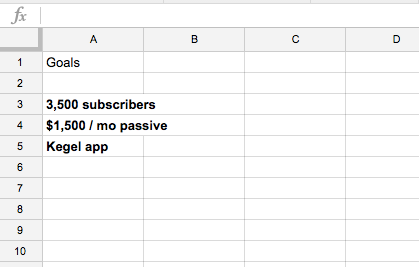
Then, create a separate tab for each goal, like this:

In each tab, record the goal at the top, and create a column for each month, like this:
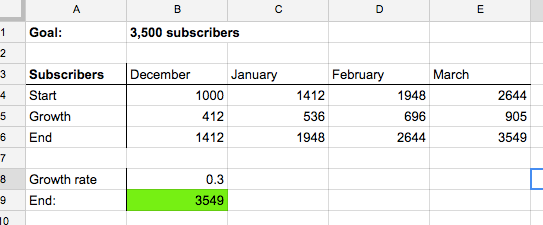
Now, in each column, you’re going to set intermediate goals.
These help you monitor whether you’re on track to hit your big goal, and give you intermediate steps to work on along the way.
Without these, it’s much easier to procrastinate on hitting your big goal, and much less likely that you actually will, so I highly recommend you take a second to set them. This is the BEST way to ensure you’re successful in hitting your goals.
For my more quantitative goals (subscribers, passive income) I just take where I am now and apply a certain month over month growth rate to it until I hit the goal number at the end of March. That tells me where I need to be at the end of each month.
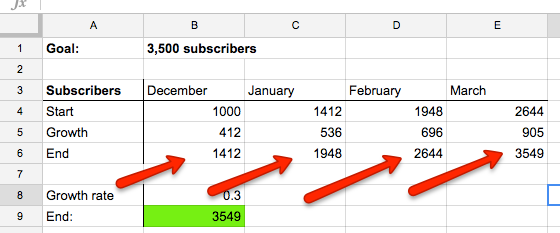
I don’t change the numbers in the boxes (until the ends of the months) I just change the growth rate until my “end” number turns green:
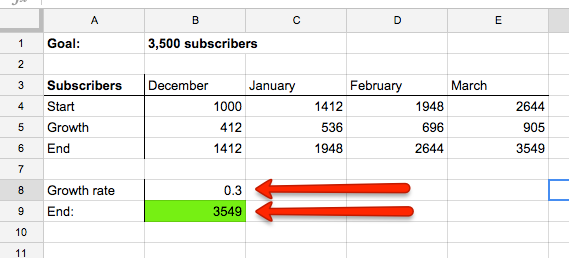
For the passive income growth, I’ve done the same thing, but I’ve broken it out by the different channels so I can see how each one is trending individually:
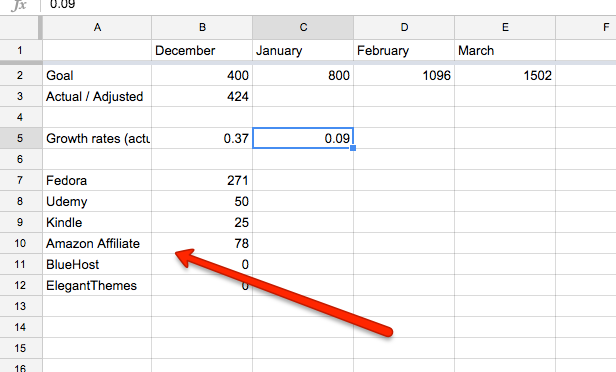
And finally for the app, there’s much less quantitative there so it’s broken out in steps instead.
Steps one and two (January + February) are just me working through a Udemy course on learning Swift, and then step 3 (March) is building an MVP (minimum viable product) of the app.
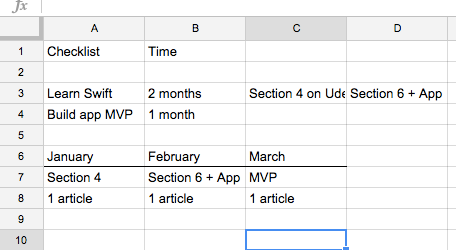
(I also threw in a 1 sex article per month goal since they’re fun to write and people really enjoy them).
Finally, I pull all of those goals back to the first sheet to create a “dashboard” for tracking my goals:
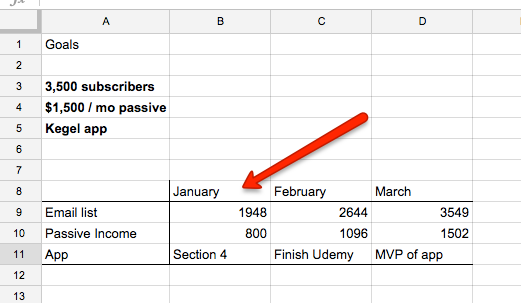
(Pro tip : set these to auto-import the numbers from your other spreadsheets as you go, or just use my template.)
Then, last but not least, I add a list of things I can do to hit the quantitative goals to the top, and add specific to-dos to the bottom:
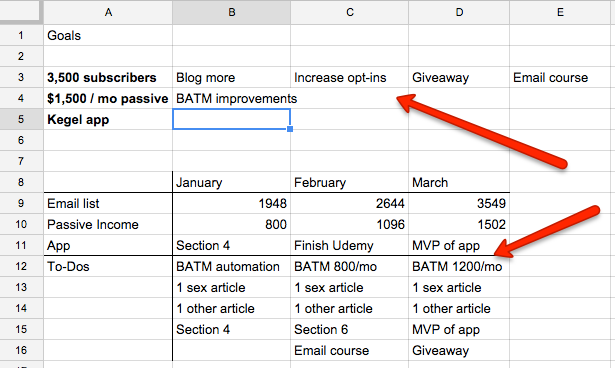
(For those of you asking, BATM is Become a Technical Marketer)
Step Five: Monitor and Adjust
Now that you know your goals, you need to constantly check in on them.
I bookmark my spreadsheet so I can quickly get to it, and then I take my monthly goals and drop them in my Trello board:
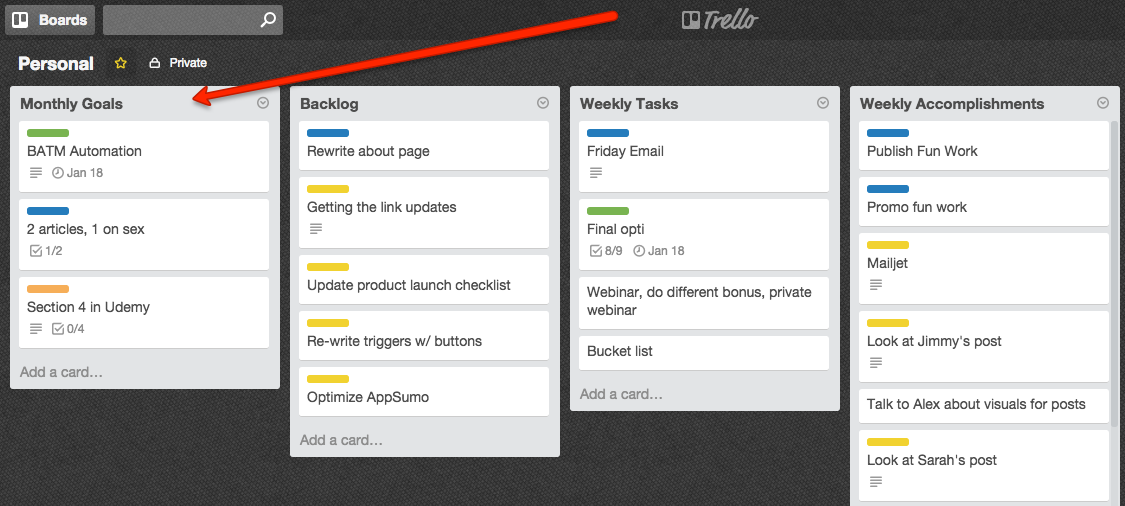
Then each week, I pull part of the monthly goals into my weekly tasks, to make sure I’m getting them done.
This way I know how I’m trending on the “to-dos” from the goals, and what else I need to get done that month.
Finally, at the end of each month, I just have to check in on how I did for the goals, and adjust the goals for the next month(s) as needed to stay on track!
Ready to get started?
Build your quantitative life goals spreadsheet now.